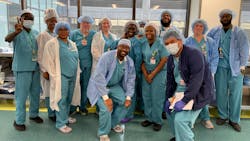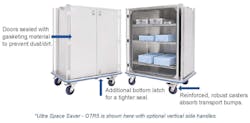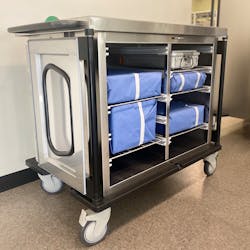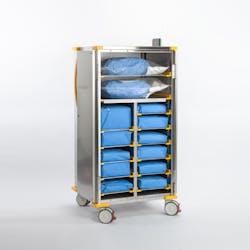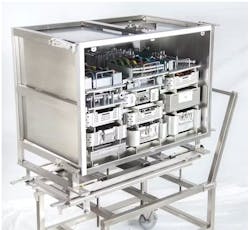Navigating case carts, kits, and trays in the surgical services setting
Case carts, kits, and trays are fundamental to supporting surgical services. Because they flow between the sterile processing department (SPD) and the operating room (OR), both teams play a role in their effective and safe use.
SPD and OR professionals, along with product and service suppliers, comment on why case carts, kits, and trays should be a focus area of improvement in today’s healthcare environment, and how SPD and OR teams can work together to enhance the design and workflow of stocking and transporting this trio of tools between the two departments.
A focus on efficiency and waste reduction
Managing surgical instruments and supplies can be a time- and labor-intensive process – from storage, picking and packing, transport to the OR, and back to the SP department – but as Ian Loper, vice president, DSI pointed out, it is usually not a target area for improvement.
“The internal workflow within both the SPD and OR is one of the most underappreciated aspects of the hospital,” said Loper. “The workflow for a patient seems to always be the focus for the hospital but not so much for these two departments.”
Loper and other experts say there is significant opportunity to optimize these processes for greater efficiency and less waste.
“There is an urgent need to address today’s operational challenges in healthcare,” said Chris Chrzanowski, manager, Healthcare Consulting Services, Asset Management, Aesculap. “Many other industries have already adopted lean processes to tackle similar issues. By adopting manufacturing practices similar to a factory concept, we could enhance many processes, including retrieval from the OR, decontamination, automated washing, instrument inspection, and delivery to the OR. This approach could automate certain operations, aiding in managing previously uncontrolled variables, such as staffing issues and procedural inefficiencies. It can contribute significantly to achieving greater efficiency while reducing costs and waste – a crucial focus area in today’s demanding healthcare environment.”
“Healthcare facilities have a tremendous need to become more efficient,” said Robert Turbett, co-founder, Turbett Surgical. “The pressures of operating costs rising put a significant strain on hospital and ambulatory surgery center (ASC) budgets. If a healthcare facility is going to thrive in today’s market, it needs to examine its daily operating processes. Steps need to be taken to not only reduce operating costs but explore how to best utilize its operating room to generate revenue. Utilizing the employees in the most efficient manner is a critical component, as staff is often the largest expense. Looking at ways to work smarter, not harder, is a key component to team satisfaction and retention.”
“Having a complete procedural supply pick (kits, trays, single sterile supplies, etc.) that is properly and safely delivered to the OR from the SPD will improve workflow, efficiency and utilization of staffing resources,” said Cory Ezell, North America Sales Director for Belintra, partnering with O&M Halyard. “If this became a focus area in today’s healthcare environment, we’d see undeniable results – such as a decreased amount of time that the OR nurse has to pick additional supplies; reduced number of times the OR nurse has to go in and out of the OR suite for product picking; improved OR turnover time; and reduced product waste.”
“Recognizing the need for more efficiency in healthcare settings, it is important to look at the process and ensure that the needs are clearly defined,” said Marcia Frieze, CEO Case Medical. “At Case Medical, look to reduce inventory by avoiding unnecessary SKUs and standardizing products that can be used for multiple purposes. Our containers are universal, durable, and designed for all current sterilization modalities. Our component parts are interchangeable, and our instrument chemistries are highly concentrated to reduce stock, avoid waste, and go safely into the wastewater stream.”
Six tips for SP/OR supply success
George Daetz, Director of Sales, Blickman Industries, Turbett, Ezell, Chrzanowski, Frieze and Loper offered the following tips for building efficiency and waste reduction into the case cart, kit-, and tray-management process.
1. Streamline surgical trays
Turbett commented on how minimizing instrument volume is an important process improvement to help eliminate waste. He stated:
“Communication between the OR and the SPD is paramount. It’s critical to patient safety that the surgeon has the instruments he needs (and desires) to have available in surgery. At the same time, keeping preference cards updated to eliminate any unneeded tools streamlines the workflow and maintains the highest level of efficiency. Utilizing reprocessing products that reduce repetitive chores is key to keeping teams satisfied.”
2. Standardize on sterile supplies and their storage
Ezell noted how sterile supplies and trays are often stored in both the SPD and the OR, making it imperative to consider the right equipment to service combined needs.
“Productivity and consistency are key for a seamless working structure between an SPD and OR. Perioperative teams should ensure their storage allows for maximum trays/supplies, transportation that can incorporate both sterile packs and loose supplies, and case carts match the growth of procedure demands. Additionally, standardizing storage capabilities and emphasizing labeling creates consistency for staff to locate items and helps them be as productive as possible.”
3. Take a system-based approach
Frieze said Case Medical takes a holistic, 360-degree approach with products that are durable, long lasting, and complementary with universal application. The company developed software with real-time data to manage operations and logistics. Work instructions identify the steps in sequence, so that all procedures are well defined. She stated:
“As a manufacturer of products for instrument processing and sterilization, we understand that each product is part of a system. The containers used for sterilization and instrument protection must be designed to fit into the various sterilizers and accommodate the devices within. Our instrument chemistries were developed to be fast-acting and free-rinsing to avoid residue and reduce waste, and be compatible with the devices to be cleaned, as well as the equipment. Our case carts used for transport have the appropriate signage, even a barcode for tracking, so that only the correct items are selected and transported to the intended destination.”
4. Consider your case cart design and path
Daetz said the emerging healthcare industry trend toward off-site sterilization and multi-facility distribution centers will make case cart optimization a focus area, particularly with regards to how case carts are transported between sites.
“It is important to understand the cart path from stocking to OR to decontamination/cart wash to restocking. Agree on one size of cart that can work in each OR.”
5. Map SP and OR workflows
To facilitate collaboration between the OR and the SPD for improved stocking and transport design of case carts, kits, and trays, Chrzanowski recommends a hospital start by digitally mapping the workspace and workflow of both departments together. He stated:
“Once both teams have a clear understanding of the workspace, prioritize and streamline the assembly of kits and trays to optimize for both areas. Incorporate accurate case cart assembly, factoring in SPD staffing schedules, surgical case mix, start times, and block scheduling. Conducting a comprehensive process and flow analysis within the OR and the SPD can help enable the implementation of a lean, efficient workflow design, benefiting both departments.”
6. Invest in the big three: people, process and products
“People are involved in pulling inventory from the shelves, loading up the case carts, then pushing the carts from the SPD to the OR,” said Loper. “Time, people, inventory, and equipment are involved in this part of the process. The sterile instruments and supplies are used in the OR, then loaded back up and rolled back down into decontamination and the SPD for processing. A process is in place and that process involves time, people, equipment, inventory, and software. So where should the hospital focus its resources: the people, the process, and the products used in every step of the way.”
“Let’s envision the SPD as being an Amazon fulfillment center and the OR being someone’s house,” Loper continued. “Amazon is incredibly proficient with order accuracy, speed with which they fill the order, delivering the order on schedule, and with close to zero damage to the contents and packaging. That’s what makes Amazon…Amazon. How?”
- Step 1: Easy-to-use end-user interface with their website for order entry.
- Step 2: The software program or enterprise resource planning (ERP) system used for inventory management.
- Step 3: An automated storage and retrieval system used for storing and retrieving products.
- Step 4: The delivery system (drivers) to the end-user.
“There are very successful healthcare-focused vendors for all four steps of this proven path but it’s up to the hospital system to earmark and make the appropriate investments to improve these processes every step of the way,” Loper concluded.
Nemours Children's Hospital navigates case carts routes for new SPD build
A major move
Like most SPDs, Nemours Children's Hospital’s previous space was in the basement, while the ORs were on the hospital’s second floor. The new SPD was moved up to the third floor, one floor above the ORs. This meant they had to establish completely new case-cart routes from the SPD on the third floor down to the OR on the second floor and then back up to decontamination. They also had to establish a safe route for dirty carts coming from outside clinics into the SPD.
“In our previous SPD on the ground floor, we had an elevator right up to the OR and into the clean core,” the hospital’s Interim SPD Manager, Jodie Lockwood, explained. “We would not have that with the new space. We had to think about how were going to get clean case carts down to OR and get dirty ones back up to decontamination. We also had to find a way to provide outside clinics access to decontamination without clinic staff having to gown up.”
The supporting structure for success
“Our last Joint Commission survey and mock survey produced no findings in SPD. That speaks to the quality that we have invested in our department, our teams, and their efforts,” said Lockwood.
A coordinated, collaborative approach pays off
Lockwood and Gilliam partnered with other members of the SPD and OR teams to facilitate a seamless transition for the SPD move.
“A lot of coordination needed to happen between both teams to make sure we could seamlessly transition from the old SPD going offline to the new one going online,” said Gilliam.
They established a multidisciplinary incident command structure and held multiple meetings each week leading up to the transition where leaders from the SPD, OR, IT, infection prevention (IP), environmental services (EVS), construction, and regulatory teams collaborated on designing the new space and related workflows around it.
“These meetings provided the opportunity for immediate discussion and resolution of issues because everyone was in the room, as opposed to a disjointed approach where different stakeholders were individually attempting to work through action items,” said Gilliam. “For example, with the help of IP and regulatory, we established dirty and clean sides of the hallways through which case carts would travel and visibly marked that distinction, so it was clear to people walking the halls.”
“We performed a ‘walk in the life’ where our frontline staff members simulated moving case carts from point A to point B,” Lockwood explained. “This allowed us as a team to identify issues and concerns before we went live in the new space.”
According to Lockwood and Gilliam, the preplanning, communication, and collaboration paid off. “The SPD was able to move with no interruption to the OR. It was seamless,” said Gilliam.
Recognition from the top
Executive leaders for Nemours Children's Hospital Delaware Valley understand the critical importance of the SPD to effective and safe perioperative services. This was evidenced by the hospital’s investment in its new SP department.
“We know the SPD is the heart of the hospital, but I think people lose sight of that sometimes,” said Lockwood. “Building a new SPD with state-of-the-art equipment – it has about everything we could ever want – spoke volumes about how much we are valued. Alongside the financial investment, my team was there at the table helping make decisions on the new space. I think the SPD team for the first time really felt they had a voice in what was happening.”
Products and solutions to support case cart, kit and tray optimization
Aesculap surgical asset management consulting services
“This can help health systems ensure timely availability of surgical assets, reduce wasted time and costs from unnecessary instrument reprocessing, and streamline sterile processing workflows to help alleviate staff burden,” Chrzanowski explained.
Blickman Over the Road case cart line
Blickman’s Over the Road carts incorporate robust casters that absorb bumps during transport, a second, bottom latch to ensure secure closure, and doors sealed with gasketing material to prevent dust/dirt from entry during transport. Customized tow-hitching options are available upon request. While designed for external transport, this line can also perform its normal internal duties as well.
DSI storage systems and case carts
DSI’s storage systems and case carts are an integrated system where the internal shelves can be used in both systems to help standardize the process. Loper said they are designed to optimize every cubic inch of storage to help maximize workflow flexibility. He added how the company’s case carts have the optionality to “trailer together and be pulled like a train.”
HALYARD and Belintra SMART-FOLD STERISYSTEM
In addition to the STERISYSTEM, the Belintra installation team has first-hand experience in the SPD and OR and can swiftly transform the workflow and storage of a facility without disrupting surgical cases.
Turbett Surgical Instrument Pod
The Pod is “the biggest step forward in efficiency an operating room can take,” according to Turbett. SPD and OR teams work together to determine the instruments needed, creating streamlined surgical kits. The Pod reduces room turnover time by taking the traditional two-person, 20-minute room set up time up time and making it a one person, one-minute process.
A recent retrospective study where a hospital used Turbett Surgical Instrument Pod found the OR was able to perform 124 more surgeries within an already full block time during a comparative six-month time frame. The hospital generated an additional $1.3 million in revenue while reducing its operating costs and waste.1
“The Pods did this while reducing the steps to reprocess the instruments and reducing the physical workload, resulting in satisfied team members,” said Turbett commented on the study. “The Instrument Pod is the perfect combination of generating revenue for a facility while dramatically improving procedural efficiency.”
More information on this can be found at www.TurbettSurgical.com, or [email protected].
References
1. Improving OR/CSP Efficiencies, Staff Satisfaction, Physician Satisfaction, and the Financial Bottom Line with Turbett Pods, OR Manager Conference, October 2022

Kara Nadeau | Senior Contributing Editor
Kara Nadeau is Sterile Processing Editor for Healthcare Purchasing News.

